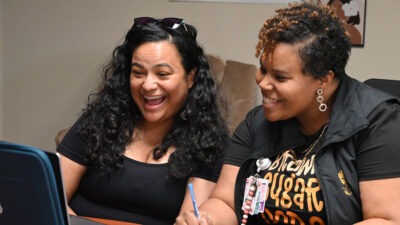Gear Up to VoteSafe seeks to help voting centers across the country operate as safely as possible throughout this pandemic.
This year, the COVID-19 pandemic has many U.S. voters concerned. Nearly 1 million people in the U.S. serve as election officials and poll workers. With the upcoming election occurring during an historic pandemic, many polling stations lack personal protection equipment (PPE) to respond to concerns of health and safety. This means voters and poll workers will take on additional risk – especially those who have underlying health conditions in low-income communities and communities of color.
Gear Up to VoteSafe, a non-partisan initiative formed by WKKF grantee RESOLVE, VoteSafe and Mission for Masks, seeks to help voting centers across the country operate as safely as possible throughout this pandemic, while making sure every American can exercise their right to vote. Safe voting guides, developed by Open Source Medical Supplies, offer advice for poll workers, volunteers and voters to ensure full electoral participation.
“With the COVID-19 pandemic still impacting the lives of all Americans, it is imperative to stay nimble and reactive to the needs of workers and volunteers who are the bedrock of our democratic voting process,” said Jess Jacobs, co-founder of Mission for Masks.
Voter Guide Recommendations:
- Make a safe voting plan. This includes checking all of your local voting requirements and options and choosing what’s right for you.
- If you’re voting absentee/by mail, look at the information sent with your ballot to see by when you must return the ballot. Your Secretary of State’s office website is a good resource for the most up to date information.
- If you’re voting in person, be prepared! Bring a mask and some hand sanitizer with you and stay at least 6 feet away from those not in your household if you have to wait in line.
- Share this information with your friends and family members when reminding them to vote!
Lifting Community Voice
“Racism does not sleep in this country,” said Daniel Dawes, author, Political Determinants of Health and director, Satcher Health Leadership Institute at Morehouse School of Medicine.
Educational opportunities, lack of access to healthy foods and increased stress are just some of the social determinants of health that lead to poor health among people of color. And these disparities are affected by a collection of policy decisions made by policymakers who either perpetuate these inequities or offer alternatives to give communities the opportunity to thrive. “One thing is clear: When communities are given the opportunity to lift up their voices with their vote, they have a hand in ensuring a brighter future for all children,” said Caroline Brunton, WKKF program officer.
Check Your Voting Precinct
Large facilities that normally house professional sporting events or concerts, along with some college facilities, are opening as “election super centers” in voting precincts around the country. Check with your states’ voter information center to see if you’ve been assigned to one of these precincts. Many of these super center precincts will have PPE on hand, but prepare to bring your own PPE and check out the Gear Up to VoteSafe safe voting guides before you go.








Comments